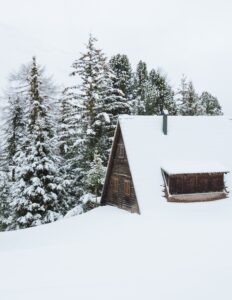How Can I Construct A Sustainable Shelter In A Snow-covered Environment? Imagine finding yourself in a snow-covered environment, surrounded by the serene beauty of nature’s winter wonderland. However, the biting cold and harsh conditions make it essential to have a sustainable shelter to protect yourself from the elements. This article will provide you with helpful tips and guidance on constructing a durable and eco-friendly shelter in a snow-covered environment. From selecting the right location to utilizing natural materials, you will discover practical solutions to ensure your safety and comfort in the midst of this snowy paradise.
Planning and Design
Researching local environmental conditions
When planning to construct a sustainable shelter in a snow-covered environment, it is crucial to thoroughly research and understand the specific environmental conditions of the area. Factors such as average snowfall, average temperatures, and wind patterns should be taken into account. This information will help determine the shelter’s design and necessary structural considerations.
Determining shelter requirements
To construct a sustainable shelter in a snow-covered environment, you need to clearly define your shelter requirements. Consider factors such as the number of occupants, desired living space, and any specific needs or preferences. This will help in determining the size and layout of the shelter, ensuring it meets your individual needs.
Considering natural resources and available materials
In a snow-covered environment, it is important to consider the availability of natural resources and locally sourced materials for construction. Utilizing natural resources and sustainable materials not only reduces the environmental impact but also ensures the shelter is well-suited to the surrounding landscape. This may include using timber from sustainable forests or incorporating natural insulation materials like straw or cellulose.
 Structural Considerations
Structural Considerations
Choosing an appropriate location
Selecting the right location for your shelter is of utmost importance. Avoid areas prone to avalanches, and choose a spot that offers protection from strong winds. An ideal location would also maximize exposure to sunlight, aiding in passive solar heating. Additionally, ensure that the site allows for proper water runoff and drainage to avoid water-related issues.
Designing a strong and stable structure
In a snow-covered environment, it is critical to design a structure that can withstand heavy snow loads. Consider sturdy construction techniques such as reinforced framing and thick exterior walls. Additionally, sloped roofs are recommended to prevent snow accumulation and potential collapses. Consulting with structural engineers or architects experienced with snow-covered environments can help ensure the stability and durability of the structure.
Accounting for snow load and wind
When designing a shelter in a snow-covered environment, it is essential to consider the potential snow load and wind factors. Understanding the maximum expected snow load in the area will guide decisions on the roof design, material selection, and supporting structures. Similarly, accounting for strong winds will help in identifying potential weak points and implementing appropriate reinforcement measures.
Insulation and Heating
Incorporating insulation materials
Insulation is crucial in maintaining a comfortable and energy-efficient shelter in a snow-covered environment. High-quality insulation materials, such as fiberglass, foam, or cellulose, should be used to minimize heat loss. Pay attention to insulating the walls, roof, and floor to create a well-insulated envelope, reducing the need for excessive heating.
Strategically placing windows and doors
Strategic placement of windows and doors is vital in a snow-covered environment. South-facing windows are beneficial for harnessing solar heat gain during the day, providing necessary warmth. Properly sealing windows and doors is essential to prevent drafts and heat loss. Consider using double or triple-pane windows with low emissivity coatings to enhance energy efficiency.
Installing a heating system
A reliable heating system is crucial for maintaining a comfortable temperature inside a snow-covered shelter. Options such as radiant floor heating, wood-burning stoves, or energy-efficient electric heaters can be considered. It is essential to choose a heating system suitable for the specific requirements of the shelter while prioritizing energy efficiency and sustainability.

Ventilation
Understanding the importance of ventilation
Proper ventilation is essential for maintaining air quality, controlling humidity levels, and preventing condensation in a snow-covered shelter. Adequate ventilation helps remove moisture buildup, which can lead to mold and mildew growth. It also replenishes oxygen levels, creating a healthier and more comfortable living environment.
Designing vents for fresh air intake and moisture regulation
Incorporate vents strategically to ensure a continuous supply of fresh air. Design intake vents at the lower levels to bring in cool, fresh air, and locate exhaust vents at higher points to allow warm, moist air to escape. This helps prevent the buildup of excess moisture and condensation.
Preventing condensation and ice build-up
To prevent condensation and ice build-up inside a snow-covered shelter, it is crucial to have proper insulation and ventilation. Ensure that insulated surfaces are airtight to prevent warm air from reaching colder surfaces and causing condensation. Additionally, installing dehumidifiers or heat recovery ventilation systems can help regulate moisture levels and minimize ice accumulation.
Water Management
Collecting and storing snow for water supply
In a snow-covered environment, leveraging the abundant resource of snow can provide a sustainable water supply. Implementing a rainwater harvesting system specifically designed for snow collection allows for the collection and storage of melted snow for various purposes. Proper treatment and filtration methods should be implemented to ensure the collected water is safe for consumption.
Managing water runoff and drainage
A comprehensive water management system is crucial to avoid water-related issues around the shelter. Designing effective drainage systems, including gutters, downspouts, and underground drainage pipes, will help redirect water away from the shelter’s foundation. Proper slope design and landscaping techniques can also aid in managing water runoff and preventing potential flooding.
Preventing freezing and ice dams
In a snow-covered environment, freezing temperatures can lead to the formation of ice dams, which can cause significant damage to the shelter’s roof and structure. Installing effective insulation and ventilation systems, proper sealing of gaps and cracks, and using specialized ice and water shield membranes can help prevent ice dams.
Energy Efficiency
Utilizing passive solar design
Passive solar design techniques can significantly enhance the energy efficiency of a snow-covered shelter. Incorporating south-facing windows, thermal mass materials, and shading devices can help maximize solar heat gain during the day while minimizing heat loss during colder periods. Proper orientation and design can effectively utilize the sun’s energy to reduce the reliance on artificial heating.
Selecting energy-efficient appliances and lighting
Choosing energy-efficient appliances, such as low-energy refrigerators, LED lighting, and efficient heating systems, is vital for reducing energy consumption. Look for appliances with high energy star ratings and opt for LED or CFL bulbs for lighting needs. Implementing smart home technologies and energy monitoring systems can further optimize energy usage.
Implementing renewable energy sources
In a snow-covered environment, harnessing renewable energy sources can be a sustainable solution. Consider installing solar panels or small wind turbines to generate clean electricity. These renewable energy sources not only reduce carbon emissions but can also provide electricity for various needs, including heating, lighting, and powering appliances.
Fire Safety
Choosing fire-resistant construction materials
In any environment, fire safety should be a top priority. When constructing a shelter in a snow-covered area, it is important to choose fire-resistant construction materials. Opt for materials such as metal, concrete, or fire-resistant treated wood for the structure. Avoid using highly combustible materials that could increase the risk of fire spreading.
Installing smoke detectors and fire extinguishers
Smoke detectors and fire extinguishers are essential safety features for any shelter. Install smoke detectors in key areas, such as bedrooms and living spaces, to ensure early detection of fire. Additionally, strategically place fire extinguishers throughout the shelter, especially in the kitchen and near heating sources, to enable a prompt response in case of fire emergencies.
Creating a safe cooking and heating area
Designate a specific area within the shelter for cooking and heating to minimize the risk of fire hazards. Use safe heating devices, such as electric heaters or properly maintained wood-burning stoves. Ensure sufficient ventilation in these areas to prevent the buildup of smoke and carbon monoxide. Follow proper safety protocols when cooking or using heating equipment.
Structural Maintenance
Regular snow removal
Regular snow removal plays a vital role in maintaining the structural integrity of a snow-covered shelter. Accumulated snow can increase the load on the roof and other structural elements, posing a potential risk. Using appropriate snow removal techniques, such as snow rakes or hiring professionals, helps prevent excessive buildup and reduces the risk of structural damage.
Monitoring and reinforcing the structure
Regular monitoring of the shelter’s structure is crucial to identify any signs of damage or weakening. Inspect both the interior and exterior for cracks, leaks, or signs of stress. Reinforce weak areas or potential points of failure promptly to ensure the shelter remains sturdy and resilient, capable of withstanding harsh snow-covered conditions.
Repairing any damages
Promptly addressing and repairing any damages to the shelter is essential to prevent further deterioration. This includes repairing leaks, sealing gaps and cracks, and replacing any damaged or compromised materials. Regular maintenance and timely repairs will help extend the lifespan of the shelter and ensure its overall sustainability.
Emergency Preparedness
Stocking up on necessary supplies
In a snow-covered environment, being prepared for emergencies is crucial. Stock up on essential supplies such as non-perishable food, water, first aid kits, flashlights, and extra batteries. Additionally, consider having emergency blankets, portable heaters, and backup power sources to sustain you during power outages or extreme weather conditions.
Creating escape routes and emergency plans
Establishing escape routes and creating a comprehensive emergency plan is essential to ensure the safety of everyone in the shelter. Clearly mark exits and ensure they are easily accessible. Conduct regular drills to practice evacuation procedures. Additionally, communicate and establish emergency protocols with local authorities and neighbors to facilitate a coordinated response during emergencies.
Having communication devices and emergency contacts
Maintaining communication during emergencies is vital. Have reliable communication devices such as radios, cell phones, or satellite phones. Keep a list of emergency contacts, including local emergency services, nearby neighbors, and family or friends who can assist in case of emergencies. Establish a designated communication point for family members or group members to gather and check-in during emergencies.
Building Codes and Permits
Understanding local regulations
Before constructing a shelter in a snow-covered environment, it is essential to understand and comply with local building regulations and codes. Familiarize yourself with zoning laws, construction standards, and any specific requirements related to snow-covered environments. Engage with local authorities or consult professionals to ensure the shelter meets all necessary regulations and safety standards.
Obtaining necessary permits
Ensure you obtain all required permits before starting the construction process. This typically includes building permits, electrical permits, plumbing permits, or any other permits specific to your area. Failure to obtain the necessary permits can lead to costly penalties and potential legal issues. Follow the required procedures, submit the appropriate documentation, and obtain the necessary approvals before commencing construction.
Meeting safety and building standards
Adhering to safety and building standards is paramount when constructing a shelter in a snow-covered environment. Ensure the design, construction, and materials used meet or exceed the relevant safety and building standards. Engage accredited professionals, such as architects or engineers, experienced in snow-covered environments to help navigate these standards and ensure compliance throughout the construction process.

 Structural Considerations
Structural Considerations